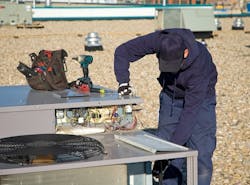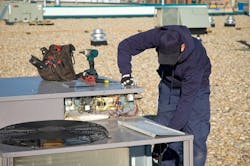Every facilities professional knows maintenance is important to keep building systems and equipment functional. That’s why manufacturers include recommended timetables and procedures in user manuals. But with shrinking budgets and limited staffs, it’s tempting to turn to a “run to fail” approach instead.
Even facilities teams that prioritize doing maintenance on time may have to focus limited resources on critical systems, like life safety infrastructure or uninterruptible power in data centers, says Jim Whittaker, engineering services lead at JLL. That leaves the less critical equipment vulnerable to early failures, which compounds the problem.
“Often, we find that non-critical base building infrastructure, things like HVAC systems, air handling units, fans, rooftop package units, and even sometimes electrical and plumbing systems, are ripe for deferring maintenance,” Whittaker says.
“Assets that people often don’t associate with preventive maintenance are things like roofs, facades and parking lots that aren’t dynamic mechanical equipment. That kind of preventive maintenance can have a big impact because things like roofing systems and pavement are very expensive, and not fixing things and doing routine maintenance can really accelerate the deterioration and create a lot more expensive damage down the line,” he continues.
Financial Impact of Ignoring Preventive Maintenance
The savings from not lubricating moving parts, replacing minor components and paying staff to complete maintenance tasks are quickly negated by the long-term costs you’ll incur through emergency service for unexpected breakdowns and more frequent replacements.
“Run to fail or repair easily costs somewhere between three and 10 times as much as a good maintenance program. When the equipment does fail, the actual repair costs are exorbitant, and you typically didn’t plan for them so there’s a financial issue,” explains David Auton, senior director of reliability engineering for Cushman & Wakefield.
“The cost of additional labor for unplanned or reactive maintenance and repair is higher than doing routine preventive maintenance because all of a sudden, you’re not in control of the resources,” Whittaker says. “Now you have higher overtime costs and possibly a need to bring in more expensive third-party contractors off hours to do work.”
Auton says, “The equipment also usually doesn’t live to its expected life, so you’re having to do capital replacement sooner than if you had maintained it well to begin with. You’re also not getting productivity. If a piece of critical equipment fails, are you just going to send everybody home for a few days while you find the parts to fix it? You’re not helping your company by having all these unexpected severe events.”
[Tech Beyond Tech’s Sake: A Case for Future-Proofed Indoor Location Services]
Undermaintained equipment also affects your budget in other unexpected ways, adds Whittaker. Failing components can impact the efficiency of other building systems that interact with the poorly maintained equipment, and sudden repair needs can also increase your staffing costs, especially for emergencies that happen outside the normal workday.
“The cost of additional labor for unplanned or reactive maintenance and repair is higher than doing routine preventive maintenance because all of a sudden, you’re not in control of the resources,” Whittaker says. “Now you have higher overtime costs and possibly a need to bring in more expensive third-party contractors off hours to do work.”
How to Catch Up with Preventive Maintenance
It’s better late than never when it comes to maintaining your building equipment. Start catching up today by creating a preventive maintenance program that addresses the worst problems first, then loops in the less critical systems.
Create a registry of all the assets and equipment that can be maintained, then add the baseline condition and criticality of each piece of equipment, Whittaker says.
“Create it as a simple project with a goal,” Auton recommends. “If your first goal is ‘All of my critical equipment has a maintenance program to prevent typical failures,’ that’s your starting point. First, you need to know what equipment is critical. Then you need to know what are the typical failure points, and what maintenance activities should be occurring and at what frequency to avoid those failures.”
Start with last year’s service history. Sort all of your repair calls from the last 12 months by type of equipment and type of failure. That will give you an idea of your facility’s current condition, Auton says. “That’s where you get into the 6:1 ratio,” Auton adds. “You should be able to perform six PMs between every repair. If you’re doing repairs between your PMs, that tells you your preventive maintenance isn’t effective.”
If you run into this problem, figure out why. Is it because you missed a step in the maintenance procedure? Are you not doing the procedure often enough?
BUILDINGS Podcast
Prescriptive Maintenance: The Next Generation Solution
[podcast]
Preventative maintenance is a crucial component to your facilities systems. Taking this one step further is prescriptive maintenance—or RxM. Listen now >>
“I’m working at a site now where belts are an issue, and in some cases, they’re replacing them every three to four weeks when they should be lasting a year,” Auton says. “What’s the problem? The issue is that A, the guys are not properly changing the belts, and B, the sleeves are worn and should be replaced. You should address that with two approaches: make sure the equipment itself is in good working condition, then do the proper belt replacement exercise, which is back the sleds off, make sure the pulleys are aligned and do the right tensioning exercise.”
Expand this practice over your whole portfolio by identifying all equipment in all of your buildings. Create a registry of all the assets and equipment that can be maintained, then add the baseline condition and criticality of each piece of equipment, Whittaker says.
“There are certain assets that may have a higher impact due to failure. A higher probability of failure increases the impact on operations,” Whittaker adds. “From there, you look at the condition and develop an asset health matrix that helps us prioritize procedures for the assets based on criticality. Look at resources to see the cost of providing the right maintenance program. If it’s been neglected and there are higher levels of maintenance required or even replacement, that would be built into the program.”
A more comprehensive preventive maintenance program may initially look like extra cost to your company’s decision-makers and extra work to your facilities crew even though it will save money in the long run. Attack that misconception before it grows out of control by getting all stakeholders on board early in the process.
“Getting top management on board requires an approach that’s nontechnical,” says Whittaker. “One of our biggest mistakes is that we try to convince executive stakeholders through technical jargon that we know what we’re doing. An executive is thinking about what is the return on their investment and how can we predict the outcomes of good maintenance programs to drive business success.”
Use this five-category framework from the National Academies of Sciences, Engineering and Medicine to demonstrate the value of preventive maintenance to executives, Whittaker recommends. It was originally developed to predict the outcomes of maintenance and repair investments in federal facilities, but can apply to any building type.
Your justification for better preventive maintenance should include:
1. Mission-related outcomes. Helping your company fulfill its corporate mission includes making sure the facility reliably functions as desired and drives business success by providing a good working environment for employees.
2. Compliance-related outcomes. Through good maintenance programs, you’re making sure that your organization is 100-percent compliant with codes, regulations and industry standards.
3. Condition-related outcomes. Preventive maintenance maximizes the value of the building or portfolio. Deferring maintenance means you’re setting yourself up to waste capital later.
4. Efficient operations. Preventive maintenance minimizes the total cost of ownership of each piece of equipment and the facility itself. Efficient workflow processes and smarter maintenance planning optimizes the productivity of the maintenance staff.
[Related: Cut Costs and Improve Services for Networks of Buildings]
5. Stakeholder-driven outcomes. “This may be the human experience element or your image with regards to customer satisfaction,” Whittaker explains. “We have accounts that talk in terms of good days, and a good day is a day when there’s no adverse impact from the facility that prevents employees from doing their jobs. If it’s a service-related industry or a manufacturer, unreliable facilities interrupt the flow of business and that can have a lasting impact beyond the costs of assets and equipment.”
Bringing the rest of the facility’s department on board will be easier, but requires good, steady leadership to implement new policies and procedures in a way that makes sense and isn’t overwhelming.
Everyone wants to be productive at work and be recognized for their accomplishments, Whittaker says, so implement your new preventive maintenance practices in a way that emphasizes doing the right maintenance at the right time with the right information to make everyone’s life easier.
“One hour of my tech’s time is the most valuable resource I have as a facilities manager,” Auton says. “If I treat one hour as money I’m spending, how can I spend that most effectively? If I have one tech who has 40 hours this week, do I want him to spend 10 hours doing unimportant stuff or spend it doing critical preventive maintenance so I’m confident this equipment is not going to fail between now and the next PM?”
Creating SMART Goals
Being an effective leader and project manager is a skill, not a talent you’re born with, explains David Auton, senior director of reliability engineering for Cushman & Wakefield. One important strategy for leading your team is communication.
Can you explain what needs to be done with your preventive maintenance program (or any other aspect of your job) and why? Define your work processes and determine what success looks like with the SMART goal framework.
Specific: Define goals in simple, clear language. Communicate exactly what you need without being vague. “Some facilities managers don’t have the technical skills to understand the technical problems, but they do know operational impacts,” Auton says. “It’s OK to tell your HVAC technician, ‘I have occupants in this area that are feeling a draft of cold air. Can you figure out what’s going on?’ You don’t have to explain it in technical terms, but you do have to be specific.”
Measurable: Be able to quantify the problem you’re solving, your progress toward the goal and the fulfillment of the goal itself. With the cold air draft example, this might mean collecting evidence and discovering that it’s a work team on the third floor complaining and the draft happens around 2 p.m. every day.
Attainable: All goals should be achievable, which means they’re defined well enough so that you can actually attain the goal with the knowledge and skills you bring to the table. What does the finish line look like? How will you know when you’ve reached it?
Relevant/Results-Focused: Is this work you should be doing? Why? What is your desired outcome?
Timebound: Link the goal to a timeframe. Is it urgent? Should it be done by tomorrow or just within the next week? All goals need a due date.
What Successful Preventive Maintenance Looks Like
A good preventive maintenance program starts with everyone being on the same page about why the procedures are necessary, Auton says. “If you break it down through the fundamentals, preventive maintenance is called preventive for a reason. When you perform preventive maintenance, what specific failure are you preventing? Do you know? If I experience failures, am I updating my preventive maintenance plan to add some steps that will make sure that failure doesn’t reoccur for that piece of equipment and all similar equipment?”
[Read also: Use HTHV Technology for Destratification in Winter]
Focus on the fundamentals of good communication when you structure your preventive maintenance program, Auton adds. Document every policy and include visuals whenever possible so that everyone can follow along.
Auton recommends a few simple rules for keeping your preventive maintenance program effective and efficient:
- Don’t do any work unless it’s documented on a work order. That way, you can track when, where and on what piece of equipment work was finished. If you have to drop everything to do emergency maintenance, fill out a work order after the fact with the scope of work so that everything is documented.
- Implement a similar documentation procedure for procuring parts and equipment.
- Have one policy for initiating, triaging, planning, executing and closing work. “I always say one process, one policy, everyone complies,” Auton explains.
A successful preventive maintenance policy also accounts for your limited budget. This may even include a “run to fail” element for equipment and parts that are cheaper to replace than maintain, Whittaker notes.
Analyzing the cost of maintenance versus downtime, repair and replacement is key to staying on budget. If you can, consider investing in a predictive maintenance tool to make it easier to track and complete maintenance.
[Related: 8 Ways to Optimize Data Center Equipment and Operations]
A CMMS package automates much of the paperwork for you, but if that’s not financially feasible, Whittaker recommends starting with inexpensive tools like vibration screening devices or oil analysis to give you extra information on which equipment needs more attention.
“These tools give you good empirical data to optimize the preventive maintenance program,” Whittaker says. “They provide greater reliability and better information on optimizing the program than just doing preventive maintenance. There are a number of predictive approaches, and they don’t have to be expensive.”
How to Pay for Projects
You can still make the upgrades and replacements you need even if your budget is low, according to Scott Pinckard, senior vice president for Prime Capital, Inc. Alternative financing structures are popular with organizations of all sizes and financial strengths who need help fitting a retrofit project or equipment replacement into their budgets.
“Many times, there are different structures that can be provided,” Pinckard says. “Some are just straightforward 100-percent financing options, but sometimes organizations find that for whatever reason they can’t incur more debt, don’t want to put more liabilities on their books or haven’t appropriated funds to do upgrades.”
Some of the alternative options include:
Equipment lease purchase agreement: If you’re able to take on some additional debt, this straightforward financing strategy may be for you.
Operating leases: The finance company retains the ownership of your new equipment while you make lease payments. You have the option to purchase the equipment once you’ve made enough lease payments, similar to rent-to-own appliances for residential customers.
Financing through an agreement: The equipment and upgrade are included in the payments for an existing service or maintenance agreement. The customer pays a higher rate for the service to reflect the cost of the equipment, but doesn’t go into debt.
“As a service” agreements: These are available in several variations, such as Lighting as a Service or Infrastructure as a Service. Similar to operating leases, but without the ownership option.
Matching payments: Some contractors will perform a detailed audit to determine expected energy savings, then match the customer’s finance payments to the savings amount so that the project is effectively paying for itself. One variation, performance contracting, involves the contractor guaranteeing the energy savings and covering the shortfall if there’s a difference between the expected and actual savings.
Appropriation language: One option popular with schools and other public entities is appropriating the annual finance payments for each year one year at a time, rather than installments on the full amount, Pinckard notes.
“Look at these projects sooner rather than later,” Pinckard says. “It’s easy to put off these types of things and say ‘We’ll do it next year.’ Act now and look into the benefits of these projects for your buildings.”
Two handpicked articles to read next:
About the Author
Janelle Penny
Editor-in-Chief at BUILDINGS
Janelle Penny has been with BUILDINGS since 2010. She is a two-time FOLIO: Eddie award winner who aims to deliver practical, actionable content for building owners and facilities professionals.


